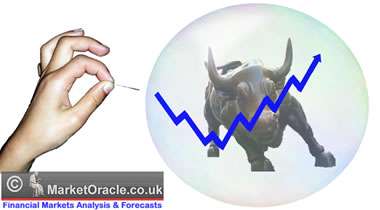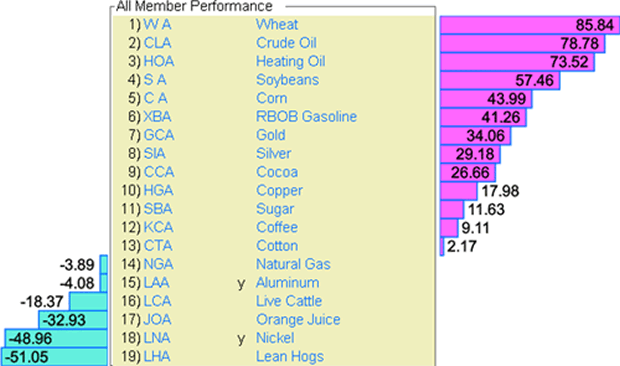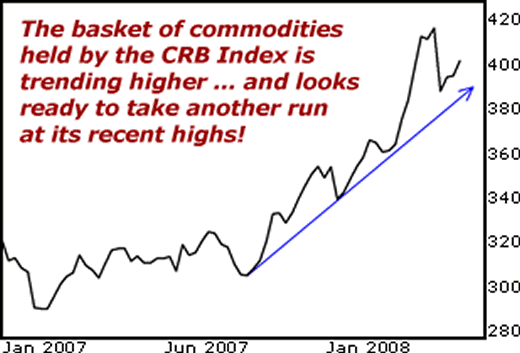Commodities Bull Market Ready to Charge Again!
Commodities / Resources Investing Apr 09, 2008 - 02:09 PM GMT Sean Brodrick writes: The last few weeks have been the roller coaster ride from hell for commodities, an up-and-down whirlwind that has left many traders feeling turned inside-out.
Sean Brodrick writes: The last few weeks have been the roller coaster ride from hell for commodities, an up-and-down whirlwind that has left many traders feeling turned inside-out.
But I think there are strong signs that a commodity correction may be coming to a close. If you're not long yet, you might want to consider putting some money to work.
After all, the inflationary forces and fundamentals that are driving commodity prices higher are still in place. Has the Fed stopped pumping money into the system? Have we stopped importing inflation from China? For that matter, have the Chinese given up on buying new air conditioners, cars, and eating more and better food? No, no and NO!
Today, I want to give you an update on natural resources. First, let's talk about the continued strength we're seeing across the board in the futures markets ...
1) Strength in gold despite bearish "fundamentals."
Consumers' appetites for gold seem to drop as prices go above $900 an ounce, and there's talk of the U.S. dollar finding a bottom. And yet, gold ended last week rebounding from its recent sell-off and looks poised for another run at its highs. When commodities go higher in the face of forces that usually drive them lower, that's pretty bullish!
Of course, it's also worth noting that the fundamental supply-and-demand issues pushing gold higher aren't going away anytime soon:
- Global gold production fell to a 10-year low of 2,444 metric tonnes in 2007, according to Gold Fields Mineral Service. This year, production will likely drop again. While China is producing more gold — up 12% — South Africa's output is falling off a cliff, down 8.1%. Gold miners are exploring frantically, but the mother lodes are getting harder to find. This should drive consolidation in the industry going forward as the big companies gobble up the smaller fish to replace their reserves.

If approved by the U.S. Congress, the IMF's planned sale of 14.2 million ounces of gold should be readily absorbed by the market. - The huge rush of gold buying by the ETFs is helping drive the market. Demand from exchange-traded funds and other funds that hold physical metal was up 16% in 2007, after jumping 25% in 2006. Now, exchange-traded funds that hold physical gold — GLD and IAU in the U.S., GOLD in Australia, GLD in Johannesburg, GBS in France and Britain — hold more gold than many central banks. What's more, a new gold ETF in India is planned for this year.
- Petrodollars are pouring into gold! Gold demand in the Middle East rose 30% in 2007. In Dubai, gold sales climbed 23.8% to $2.6 billion. In Saudi Arabia, gold demand rose 15.2% to 120.2 metric tonnes while sales value rose 33.3% to $3.2 billion.
Speaking of petrodollars ...
2) Like it or not, we live in a global, petroleum-based economy.
Oil inventories are building week after week, and yet crude prices are trending higher. Why? As the name implies, oil futures trade on the perception and anticipation of the future .
 |
| Oil has climbed to record highs as futures traders bid up the price. |
We talked about the supply-and-demand issues facing gold a moment ago. Oil is facing similar issues, but the potential severity is multiplied a thousand-fold!
Like it or not, we live in a global, petroleum based economy. If a real disruption in the supply of oil were to occur, the Fed could pump a trillion dollars into Wall Street, and still the NYSE would still collapse.
Even if the unthinkable never happens, traders look at the following data and project it out into the future ...
- Mexico is one of our major foreign oil suppliers. But the situation in Mexico's aging, under-financed oil fields is going from bad to worse. Production began to fall in 2005, and Mexico may have to import light crude for its refineries by 2011, according to Energy Minister Georgina Kassel. Without new production, daily oil exports may plummet to 289,000 barrels in 2016 from 1.67 million last year.
- Russia is one of the world's biggest oil exporters. But Russian oil output may fall this year for the first time in a decade. Output fell 0.7% in January and 0.9% in February, to 9.79 million barrels a day.
- Global demand for oil continues to rise. The International Energy Agency expects demand to rise 2% this year to 87.54 million barrels a day. That's over 1,000 barrels a second!
3) A worsening global agriculture crisis.
I've told you in recent columns how billions of people in China and India are changing their diets — eating more and better food. The Chinese ate just 44 pounds of meat per capita in 1985. They now eat over 110 pounds a year. Each pound of beef takes about 7 pounds of grain to produce, which puts even more pressure on grain prices.
As a result ...
- Global wheat stockpiles are at 26-year lows and U.S. wheat stocks are at 59-year lows. Soybean stockpiles are also at multi-decade lows. Now, the same thing is happening in rice. World rice stockpiles are at their lowest levels since the 1980s, and the United Nations forecasts that exports will drop 3.5% this year.
- As of last December, 37 countries faced food crises, and 20 had imposed some sort of food-price controls.
- The prices of the world's three main grains — rice, wheat and corn — have all more than doubled in the past year. Over the past eight years, the price of food worldwide has increased 75%; the price of wheat has gone up a dramatic 200%. The rate of inflation is accelerating. In a recent report, the United Nations predicted that food prices are likely to remain high for a decade.
As you might imagine, all this is putting a tremendous upward squeeze on agriculture commodities ... and fattening the bottom lines of agriculture companies. But that's not all ...
4) Basic materials are soaring, too!
Korean steel giant Posco just agreed to a tripling of the price of coking coal, the kind used to make steel. That sets the bar for industry much higher. Meanwhile, iron ore prices jumped by between 65% and 71% for the 12 months starting in April as demand from Chinese steelmakers outpaced global supplies.
And copper is going higher, too — Citigroup boosted its 2008 forecast for copper prices by 15%, citing rip-roaring demand from, you guessed it, China.
How do we line up a surge in demand in basic materials with calls we're hearing for a global recession? Answer: We don't!
Somebody is obviously wrong — you can't have demand and prices soaring at the same time that a global recession is taking place. Me, I'm following the money — I'm betting on commodities.

Just look at this one-year performance table. Gold is up 34% ... pretty good, until you compare it to soybeans (57.4%), heating oil (73.5%), crude oil (78.8%) or wheat (85.8%)!
The trend is your friend, and I think this trend could continue a good while longer. It turns out I'm not the only one ...
A Fund Manager Worth Listening to
Recently, I had a good chat with Frank Holmes — CEO and chief investment officer of U.S. Global Investors. I often recommend his mutual funds in Money and Markets because I like his investing style.
For example, he says that rather than inflation, "What we're seeing is the end now of mass deflation."
We've seen inflationary cycles before — for example, in the oil embargo of the 1970s — but this time, Frank believes, inflation is demand driven, not supply driven.
For example, he says: "Now we're seeing food inflation. That's partly our policy of ethanol. The rest of the world is eating wheat and corn," he says, while we're trying to run our cars on grain.
"We can resolve that," Frank says. "The bigger picture that most people fail to grasp is the significance of the super-cycle. In the 1970s, there were 3 billion people on Earth. Now, there are 6.5 billion people. In fact, we have 3 billion people just living in city centers."
By 2030, there should be 8.3 billion people on Earth, and six out of 10 of them will live in cities!
And the countries where that population boom is taking place are countries where people covet the Western lifestyle.
"In 1970, China and India had no global footprint," Frank points out. "Today, they're approaching 20% of global GDP."
And that footprint could get a lot larger. Those two countries contain 40% of the world's population.
"There is an economic infrastructure revolution taking place," Frank says. "In January, China and India announced their next 5-year plans, with trillions of dollars in infrastructure spending."
Clearly, these spending plans are lighting a fire under commodity prices.
Before this super-cycle is over, Frank says he expects to see copper — currently around $4 per pound — at $6 or even $8 a pound. Meanwhile, he points to a lack of planting in soft commodities and a lack of exploration in hard commodities as forces that will drive the cost of both much, much higher over the long term.
And as for oil, he's looking for a pullback, but he also doesn't think we've seen the high prices for the year, either. The long-term picture hasn't changed.
I tend to agree with Frank's outlook. And beyond the signs of strength in commodities, the long-term forces driving prices higher are irrefutable. Here's ...
How to Play It
I think a couple of Frank's no-load U.S. Global funds are great plays in the global commodity super-cycle.

For example, the Global Resources Fund (symbol PSPFX) runs the gamut of commodities.
And the Global MegaTrends Fund (MEGAX) is stacked with companies that should benefit from the infrastructure build-out — stocks including Schlumberger, First Solar, Chicago Bridge & Iron, and more.
Or if you wanted to use an exchange-traded fund, you could check out the PowerShares DB Commodity Index Tracking Fund ETF (DBC).
A quick glance at a chart of the widely-tracked Reuters/Jeffries CRB Index of 19 commodities shows you that while it has pulled back from its recent highs, it is still trending strongly higher.
In fact, that pullback looks like a good opportunity to get onboard — before this profit train leaves the station.
Yours for trading profits,
Sean
This investment news is brought to you by Money and Markets . Money and Markets is a free daily investment newsletter from Martin D. Weiss and Weiss Research analysts offering the latest investing news and financial insights for the stock market, including tips and advice on investing in gold, energy and oil. Dr. Weiss is a leader in the fields of investing, interest rates, financial safety and economic forecasting. To view archives or subscribe, visit http://www.moneyandmarkets.com .
Money and Markets Archive |
© 2005-2022 http://www.MarketOracle.co.uk - The Market Oracle is a FREE Daily Financial Markets Analysis & Forecasting online publication.



